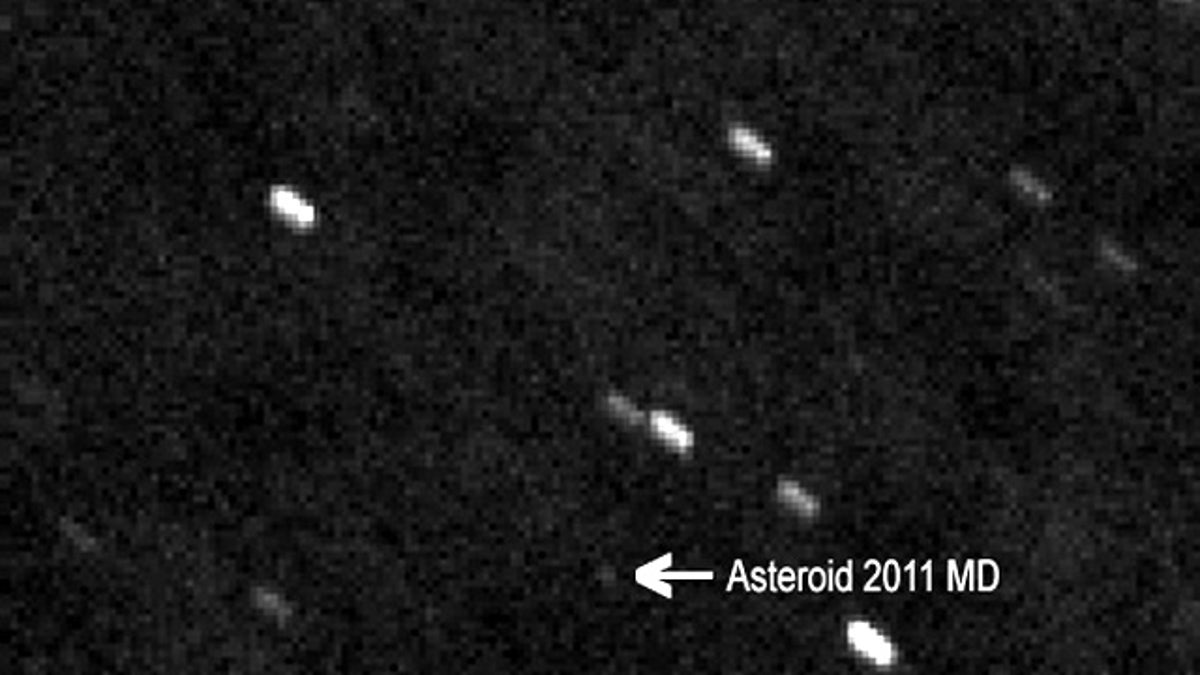
Skywatcher Peter Birtwhistle of the Great Shefford Observatory snapped this image of asteroid 2011 MD on June 23, 2011. The asteroid zipped within 7,500 miles of Earth on June 27. (Peter Birtwhistle/Great Shefford Observatory)
An asteroid the size of a tour bus zipped by Earth Monday -- a flyby so close that the space rock was nearer to the planet than some satellites.
The space rock, called asteroid 2011 MD, reached its closest point to Earth just after 1 p.m. EDT (1700 GMT), when it crept within 7,500 miles (12,000 km) of Earth before whipping away again like a slingshot. The asteroid was flying over the southern Atlantic Ocean, off the coast of Antarctica, at the time of its closest approach.
The asteroid was discovered just last week on June 22, but there was never any risk of it impacting Earth, NASA scientists said. Astronomers with the LINEAR near-Earth object survey in Socorro, N.M., made the find.
The space rock is on the small side, with latest size estimates ranging from 16 to 66 feet (5 to 20 meters) wide.
That means asteroid 2011 MD would likely be too small to survive the fiery plunge through Earth's atmosphere, let alone reach the surface, NASA scientists said. Asteroids this size can be expected to buzz Earth with close shaves about once every six years, they added.
A photo of asteroid 2011 MD snapped by astronomer Peter Birtwhistle of the Great Shefford Observatory in the United Kingdom on June 23 revealed the space rock as little more than a dim, moving point of light.
The asteroid's close brush with Earth sent it off on a new trajectory through the solar system. The space rock flew well below geosynchronous satellites, which orbit 22,236 miles (35,786 km) above Earth, but well above the 220-mile (354-km) altitude of the International Space Station.
There was little chance the asteroid would hit a satellite because of the vastness of space and the relatively small number of satellites, experts said.
Hard-to-spot asteroid
Don Yeomans, of NASA's Near-Earth Object Program Office at NASA's Jet Propulsion Laboratory in Pasadena Calif., told SPACE.com that astronomers hoped to take radar observations 2011 MD during the asteroid's flyby. However, hopes were low for any detailed images because of the space rock's small size, Yeomans added.
Only seasoned skywatchers with medium-sized telescopes were expected to see the asteroid at all, NASA officials said.
When the asteroid was first discovered, the early reports suggested that it would make its closest approach to Earth on about 9:30 a.m. EDT (1330 GMT), more than three hours earlier than the actual event. But that report was based on just two days of observations, Yeomans said.
"The new improved orbit has 4 days of observations rather than two, and the current Earth close approach time is now 1:00 pm EDT on Monday," Yeomans said in an e-mail. "This time should be good to a few minutes."
Earth's asteroid close shaves
Asteroid 2011 MD is the second space rock to zip extremely close by Earth this year. The other object, called asteroid 2011 CQ1, passed within 3,400 miles (5,471 kilometers) of Earth on Feb. 4, making it the closest known flyby of an asteroid to date.
NASA scientists and other astronomers search for near-Earth space rocks like 2011 MD as part of a program to identify potentially hazardous asteroids that could threaten the planet.
* 5 Reasons to Care About Asteroids
* Photos: Asteroids in Deep Space
* Video: Top 10 Best Amateur Telescopes
Copyright © 2011 Space.com. All Rights Reserved. This material may not be published, broadcast, rewritten or redistributed.
